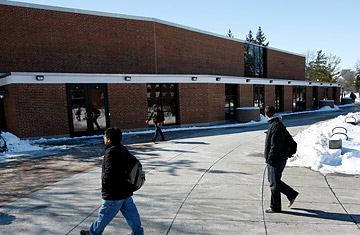
Students of Northern Illinois University walk by Cole Hall, the scene of the shooting, in DeKalb.
Should the scene of a mass murder be demolished or preserved in a commemorative way? Northern Illinois University, the site of the Valentine's Day slaughter of five students and the apparent suicide of the killer, is now facing the same question that Columbine and Virginia Tech earlier had to grapple with.
In NIU's case, the issue seems to have been fast-forwarded by Illinois' flamboyant and controversial governor, Rod Blagojevich, who announced on Wednesday that he would seek $40 million in state funding to raze the building where the massacre took place. The governor, embattled by several political controversies, apparently took it upon himself to publicize plans to do so by the university. Blagojevich probably thought he would thus be soothing the feelings of students and professors distressed at the prospect of returning to Cole Hall. But the governor immediately came in for criticism.
Under the plan announced by Blagojevich, NIU's Cole Hall is to be demolished this spring, and a new building, Memorial Hall, is expected to open by 2011. It is to be about 40% larger than Cole Hall, and will include 10 classrooms, as well as three 250-seat auditoriums. But some at NIU are not sure that is the perfect way to remember the trauma. "It almost seems like they're letting fear dictate their actions. People are trying to say that what [gunman] Steven Kazmierczak did can't stop us. But by tearing down Cole Hall, it does stop us from living as we normally would," says Colin Leicht, a 27-year-old NIU senior.
Columbine High School was faced with the same issue. In the days following the April 1999 massacre in which 12 students and a teacher were killed, the school formed committees to carefully consider the building's fate. "Right after the tragedy, emotions were high, very high," recalls Frank DeAngelis, the school's principal for the last dozen years. The committees dismissed suggestions to demolish the building. "There was the belief that if we tore down the buildings, the two murderers would have won," DeAngelis says, referring to the high school seniors who staged the Columbine attacks. Instead, the school opened the floor of the library where most of the students were murdered to create an atrium above the cafeteria. The school built an extension housing a new library, which features a 250-gallon saltwater fish tank that mental health professionals advised would have a calming effect on some students. That's also partly why the sterile grayness of some hallways was painted over with tranquil pastel colors. And that's also why the blaring fire alarm was replaced with one DeAngelis likens to British police sirens.
At Virginia Tech, officials met over several months to decide what to do with the two buildings where a gunman killed 32 students, and then himself. Simply tearing down Norris Hall, where most of the murders occurred, wasn't practical: It would have been a costly endeavor, and the building houses several high-tech labs and faculty offices, primarily for the university's department of engineering science and mechanics, one of the school's largest programs. The school closed the building for several months. Now, it plans to convert the building's second floor into a center for peace and violence prevention studies. The dormitory suite where two students were murdered is also being reconfigured. "It will be something completely different," says Larry Hincker, Virginia Tech's assistant vice president for university relations. "There are a lot of people on this campus who are still just freaked out about it. I was one of them."
Apart from keeping Cole Hall as a memorial, the loudest arguments against razing the 40-year old edifice are financial. The $40 million estimated cost for the project is hard to justify after iffy state funding threatened to paralyze metropolitan Chicago's public transportation system.
Cole Hall has long been on a list of buildings NIU officials had hoped to renovate or demolish in the coming decade. The building's two 500-seat lecture halls typically held just 160 or so students in introductory classes. It has no study rooms, no offices. On a growing campus of roughly 25,000 students, the building, officials argue, is obsolete. Given its design, says Melanie Magara, NIU's assistant vice president for public affairs, "You can't remodel it. It cannot be repurposed. It's just a shell. It didn't take too long to come to the conclusion we needed to raze the building and perhaps build a new one." But, some observers ask, might it be possible — and more cost-efficient — to convert the two lecture halls into a collection of smaller classrooms? And why spend so much money tearing down a building that is still structurally sound? Leicht, the NIU senior, says he sensed little university effort to solicit an array of student opinions about Cole Hall's fate. Instead of tearing it down, he suggests the school not only convert the two lecture halls into classroom space, but put some of the memorials left outside the building in recent weeks inside a hallway between the two halls.
Given the largely negative public reaction, Blagojevich's aides moved quickly to distance him from the plan — just one day after announcing it. The governor may have wanted a distraction from his other problems. Last week, a federal judge named Blagojevich as "Public Official A" in the corruption case of Antoin Rezko, a prominent fund raiser who has also been linked to both Barack Obama and Hillary Clinton. The NIU aftermath, however, isn't going to quiet things down for Blagojevich.
